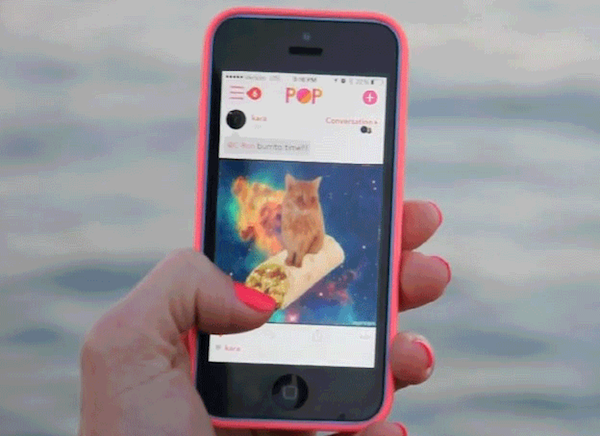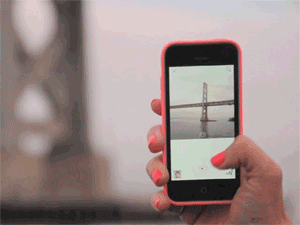
The people behind Zeega are taking their mashup sensibilities into the world of mobile with Pop, a new iPhone app released today that lets users smash together the world in front of them and the World Wide Web.
Pop is equal parts social and visual storytelling. Users create a Pop by snapping a photo or taking a short video, then combining their media with a GIF. (Similar to how the company is named Zeega and has a product named Zeega, in Pop you make and share a Pop. That’s right, you Pop-Pop.) When viewing a Pop, the photo or video is shown until you press on it, when the underlying GIF is revealed.
The effect is a little like playing with a pop-up book you control with a tap of your finger. What’s made in Pop is mostly shared in Pop, but users can also share their creations with the outside world by tweeting, texting, or emailing a link. (Non-mobile users will have to settle for clicking and holding their cursor in place of a finger.) The app itself is similar in design and spirit to Vine, but instead of sharing six-second videos, you can express yourself through a bacon-Putin sandwich.
Pop clearly shares some of the same DNA as Zeega itself, which let people remix the web by sampling videos, photos, GIFs, and audio into a new kind of digital presentation. (Zeega originally launched down the street from us here in Cambridge before the team moved out west; it won a Knight News Challenge grant in 2011.) But Pop simplifies the process, both by removing the vast majority of Zeega’s functionality and by the nature of making it mobile-first. “There’s a hunger to be able to create in the moment,” said Jesse Shapins, cofounder of Zeega and Pop. “There’s a unique power that mobile technology gives us today to record in the moment as well as be connected to the Internet.”
Creating the app with mobile remixing and viewing in mind means you have to play within the limits of what is capable on a smartphone, Shapins said. Those limits, similar to the constraints that define products like Twitter, Vine, or Snapchat, are what ultimately make the apps accessible and durable, Shapins said. “We realized if we said ‘Let’s make Zeega on a phone,’ to meet that principle, we would have to change it dramatically,” Shapins said.

Where Zeega was open-ended and offered the breadth of the web, Pop is limited by a number of factors: You only get two media elements, you have to use your phone’s camera, and you get to play with a limited supply of GIFs. The GIFs in this case are supplied by Giphy, and the selection is a constantly changing mix of GIFs that are timely or trending, Shapins said. “From the beginning, we wanted to make the best experience that’s possible within the app, but also open and accessible to the web,” he said.
The thread that connects Zeega and Pop is finding ways to express yourself through technology with some creativity, Shapins said. But the similarities between the two start to break from there.
The company and the idea evolved over the years, from its funding from Knight and later from Matter, the media accelerator. Zeega found some success partnering with NowThis News — which used it for oddball day-in-review roundups — and being used for things like the Association for Independents in Radio’s Localore project. In particular, the project with AIR showcased Zeega’s potential as a newsroom tool that journalists could deploy for finding new ways to tell stories. But as the company shifted its focus to develop new products like Pop, some journalists were concerned about the support available for reporters using Zeega.
While Zeega attracted a small audience of journalists, creatives, and the tech-inclined, Shapins said usage levels could be inconsistent at times. Zeega will continue to live on as the company further develops Pop, Shapins told me. “A challenge we saw was many people of that nature would come, fall in love with the platform for a moment, but not necessarily tie it into their daily life,” he said.
The decision to change course came during Zeega’s time at Matter, where Shapins, along with co-founders Kara Oehler and James Burns, began re-evaluating and testing their original product. The decision to go mobile was influenced by the growing audience on smartphones and other devices, Shapins said. Zeega, as they had built it, was more oriented towards the world of laptops. “We saw and witnessed an interest from people to create things that maybe have a characteristic of Zeega while they are out in the world,” he said.
Corey Ford, managing partner for Matter, said that coming into the accelerator, there was dissonance between what Zeega wanted to do and what the team had actually created. “They came in with a great vision, but an overly complex, bloated product in the original Zeega,” he said.
But Ford said they moved quickly into reinvention, after taking advice from some of the consultants and participants at Matter to focus on mobile. “You always want to think of the context you’re designing for, and the thing about what they’re trying to do, it’s not an unlikely hypothesis to say [users] would be starting on their phone,” Ford said.
Ford said he has high hopes for Pop because of the amount of time the team put into user testing and rapid prototyping during the accelerator. Of course, the next big obstacle is attracting a user base for the app.
“I’m just really proud of how successfully they were able to navigate what I call the drunken walk of the entrepreneur,'” said Ford. That walk, Ford explained, is the kind of winding, unplanned, and possibly precarious way entrepreneurs make discoveries on the way to building a product.
“Entrepreneurship is a discovery process — it’s not about coming up with some perfect plan and executing on that plan,” he said.